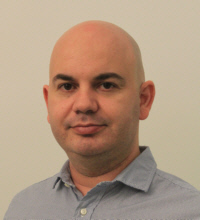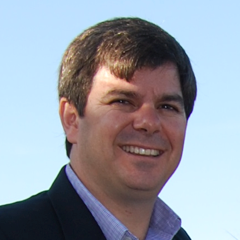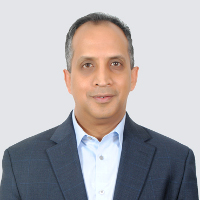2017 Conference Program
BPM Thought Leadership Sessions
 BPM 2017-2021: Outlook for the Next Five Years
BPM 2017-2021: Outlook for the Next Five Years
Nathaniel Palmer, BPMNEXT Co-Chair
This kickoff session presents an expert view of the BPM market landscape, projected over 2017 to 2021. Discussion will center on those trends with the greatest impact, both within the BPM market as well as outside, including AI, Automation, Decisions, Analytics ? and what these all mean for the business of BPM. This discussion will also be framed within the latest market research conducted by BPM.com and other relevant analysts.
Rated as the # 1 Most Influential Thought Leader in Business Process Management (BPM) by independent research, Nathaniel is recognized as one of the early originators of BPM, and has the led the design for some of the industry?s largest-scale and most complex projects, involving investments of $200 Million or more. Today he is Vice President and Chief Technology Officer of Business Process Management, Inc. as well as the Executive Director of the Workflow Management Coalition. Previously he had been the BPM Practice Director of SRA International, and prior to that Director, Business Consulting for Perot Systems Corp, as well as spent over a decade with Delphi Group serving as Vice President and Chief Technology Officer. He frequently tops the lists of the most recognized names in his field, and was the first individual named as Laureate in Workflow. He is a regular speaker at leading forums and industry user groups, such as AGA, AIIM, Forrester, Gartner, FSO Knowledge Xchange and SOA Symposium. He has served on the boards of Align Journal, COMNET, eDOC Journal, Infonomics, and AIIM New England. Nathaniel has authored or co-authored a dozen books on process innovation and business transformation, including ?Intelligent BPM? (2013), ?How Knowledge Workers Get Things Done? (2012), ?Social BPM? (2011), ?Mastering the Unpredictable? (2008) which reached #2 on the Amazon.com Best Seller?s List, ?Excellence in Practice (2007), ?Encyclopedia of Database Systems? (2007) and ?The X-Economy? (2001).
 The Top 10 Technologies that Will Impact BPM in Next 5 Years (Or Don’t Get Caught with your Technology Down)
The Top 10 Technologies that Will Impact BPM in Next 5 Years (Or Don’t Get Caught with your Technology Down)
Jim Sinur, Aragon Research
There are a multitude business and technology trends emerging today that have to be dealt with now to be in a position to intercept the future process markets. Learn what technologies are emerging and evolving over the next few years to position BPM to be a winning partner for our clients.
Jim Sinur joined Aragon Research in 2016 as a Vice President and Research Fellow. As a distinguished Thought Leader, he covers Digital Transformation, the Digital Business Platform (DBP), the Internet of Things(IoT), Cognitive Delivery, and the Intelligent Workplace. Prior to joining Aragon, Mr. Sinur spent 20 years at Gartner, where he was critical in creating the first Hype Cycle and Maturity Model, which have become a hallmark of Gartner analysis, along with the Magic Quadrant.
 The New Wave of Automation
The New Wave of Automation
Neil Ward-Dutton, MWD Advisors
There?s a new wave of work automation now starting to impact businesses. Yes, partly this is enabled by Machine Learning technologies and techniques: but there?s more to it. The new wave of automation brings advances in interaction, insights and integration.
Neil Ward-Dutton is MWD Advisors? co-founder and Research Director, and is one of Europe?s most experienced and high-profile strategic IT advisors and industry analysts. His areas of expertise include digital transformation, business process management (BPM), enterprise architecture (EA) and IT strategy. Neil acts as an advisor to large European organisations across industries and sectors as diverse as financial services, retail, utilities and government ? as well as providing advice to a number of leading technology vendors.
 The Great Migration: How to Survive the Leap From BPM As We Knew It To The Era Of The Digital Workforce
The Great Migration: How to Survive the Leap From BPM As We Knew It To The Era Of The Digital Workforce
Clay Richardson, Digital FastForward
Digital is exploding and organizations don?t have the skills or know where to go to make sure employees are able to handle the future challenges of digital business. In the midst of this migration to digital, BPM programs are adopting new technologies – such as robotic automation, cognitive intelligence, IoT, and mobile – at a rapid pace to meet the demands of internal and external customers. To capitalize on these new technologies, business process leaders need to build new technology skillsets that prioritize design thinking, digital experimentation, data science, and digital business automation. This session will share next generation strategies and examples for building the future digital workforce.
Clay Richardson is CEO & co-founder of Digital FastForward, a digital skills accelerator that delivers immersive bootcamps and consulting on design thinking, digital innovation, and lean startup strategies. Formerly with Forrester Research, Clay led research on the intersection of business process management, customer experience, and digital transformation. He is a frequent keynote speaker at industry events, technology conferences, and customer forums around the world. Clay is a certified facilitator of the Edison Award-winning IDEO ExperienceInnovation methodology, and also serves as an Entrepreneur-In-Residence at The American University Center For Innovation.
 The Recipe for Successful Digital Transformation
The Recipe for Successful Digital Transformation
Derek Miers, Structure Talent
So often, transformation programs are envisaged with a happy path of change; when the reality is anything but happy or as predicted. The assumption is that executives can just dictate the result and then it is up to strong managers to make it so. We all know that just doesn?t work. The trick is to design the future rather than attempting to fix the past.
Derek Miers focuses on the methods, approaches, frameworks, techniques, and technologies of business architecture, transformation and target operating models. His deep competence is around BPM; business process improvement; and organizational change. He places a special emphasis on an outside-in, outcome-based, customer-focused approach. His engagements usually focus on helping major organizations charter and establish their change programs, ensuring the change has the best chance of success. Prior to joining Structure Talent, Derek spent 5 years at Forrester Research working in both research and consulting. He led the Business Architecture research practice for 2 years, before which he focused on BPM, Case Management and Organizational Transformation. While at Forrester Derek published over 60 different research reports exploring these themes.
Process Innovation Demo Program
 Creating a Digital Workforce with Robotic Process Automation
Creating a Digital Workforce with Robotic Process Automation
Anthony Yung, Kofax
Organizations are beginning to deploy intelligent software robots as an agile digital workforce. The activities performed by robotic process automation (RPA) include both routine back office data processing and strategic process activities. Robotic process automation solutions augment and complement Business Process Management and Case Management solutions, not replace them. Lexmark?s RPA software is built on a scalable multi-threaded architecture, currently available either on premises or in the cloud.
Anthony Yung is currently serving as a Sales Engineer with an emphasis of Kofax Kapow. Anthony has over thirty five years of experiences working with several technologies. He served as an Account Executive, Partner Development Manager, Enterprise Architect, Pre-sales Engineer, Project Manager, Director of Information Systems, Systems and Solution Architect, and trained in Lean Six Sigma Black Belt. He practiced solution and valued based selling. He has experiences in strategic, territory, and transaction sales processes. The current focuses are to assist partners and customers to design solutions leveraging RPA (Robotic Process Automation) technologies.
 Real-time Process Deviance Monitoring
Real-time Process Deviance Monitoring
Michal Rosik, minit
While deviations from the desired process path represent increased costs and lost revenue, companies lack tools for monitoring complex processes spanning multiple systems and departments within the organization. Minit uses process mining of enterprise system event logs to establish a baseline for performance monitoring. Then its real-time process deviance monitoring performs continuous process mining to detect deviations in critical processes, enabling quick reaction to issues as they arise.
As Product Visionary for minit, Michal Rosik defines the Research & Development direction for this process mining solution, develops close ties to the academic community in this area and evangelizes process mining benefits to enterprises worldwide. Michal previously lead Microsoft Consulting department in Siemens and was involved in several large enterprise projects as a consultant and project manager. In his free time, he is a passionate trail runner.
Analytics for leveraging BPM assessment and Management Action
Jude Chagas Pereira, Frank Kowalkowski, Gil Laware, IYCON
BPM products provide excellent documentation and management capability to support process improvement. Further, standards such as BPMN2, core quantitative performance measures and simulation tools provide the prospect of consistent data driven analytical views. BPM automation, innovation and digitization strategies are driving more management options for transformation. Execution platforms simplify the ?go to operation? time of process transformation. However, the level of uncertainty in deployment still depends on the degree to which process change impacts and priorities are known. However, there is a growing gap in management capability to realize results from newer process deployment technologies. This gap increases uncertainty and unintended consequences from all the new capabilities BPM products provide. This limits effectively transforming the organization in deploying new process suites. There is an opportunity to increase the value of existing BPM products and methods through extended analytics. Afterspyre is a unique engine that couples quantitative and semantic analytics. Organizations and their processes are enabled by many decisions that require high quality analytics for reducing uncertainty. Afterspyre analytics promote quality decision results.
 Jude Chagas Pereira
Jude Chagas Pereira
CEO at IYCON with responsibility for achieving the company’s vision of being the “Preferred Global Execution Partner for Government and Businesses”. He has been instrumental in conceptualizing the best practice framework for Process and Risk Integrated Strategy Execution (PRISE). He was awarded the Business Leadership Excellence Award in 2015 from the World Leadership Congress. Over the past 4 years, he speaks on strategy execution at the Strategy Leaders’ Summit.
 Frank Kowalkowski
Frank Kowalkowski
President of Knowledge Consultants, Inc., a firm focusing on business performance, business/IT architecture and business analytical techniques. He has been involved with many projects including business analysis, process management, business performance measurement, business and competitive intelligence and knowledge management. In addition to being a keynote speaker at international conferences he conducts frequent seminars internationally on a variety of topics. He is the author of a book on Enterprise Analysis.
 Gil Laware
Gil Laware
CEO of Information By Design (IBD), Inc., has over 35 years of consulting and industry experience with Fortune 50 companies. He was Associate Director for Fujitsu Consulting, Manager of Data Services for Whirlpool Corporation, and held various managerial and consultative roles with the IBM Corporation. He was an Associate Professor in the College of Technology at Purdue University and co-authored the 2015 book on ?Business and Dynamic Change: The Arrival of Business Architecture?.
BPM with Blockchain
Miguel Valdes-Faura, Lionel Palachin, Bonitasoft
Blockchain technology is enabling a paradigm shift in how companies do business by providing a new way to exchange assets. Blockchain is indeed much broader than Bitcoin and can be seen as an immutable, unhackable distributed database of digital assets. There are growing number of Blockchain implementations in different domains such supply chain management, digital voting, cloud storage or IOT network, to name a few. This session will illustrate different use cases in which blockchain and BPM technologies can support and strength each other. We will demonstrate how Bonita BPM platform and Chain Core technology can be combined to create blockchain apps. We will also cover how to perform intelligent queries on any part of a Blockchain transaction and how Smart contracts and their underlaying processes can benefit by the use of BPM technologies.
 As Chief Executive Officer and co-founder of Bonitasoft, Miguel leads the charge in the company?s mission: to democratize Business Process Management (BPM), bringing powerful and affordable BPM to organizations and projects of all sizes. Prior to founding Bonitasoft?now the global leader in open source BPMS?Miguel led R&D, pre-sales and support for the BPM division of Bull Information Systems, a major European systems provider. Miguel is a recognized thought-leader in business process management and passionate about open source community building.
As Chief Executive Officer and co-founder of Bonitasoft, Miguel leads the charge in the company?s mission: to democratize Business Process Management (BPM), bringing powerful and affordable BPM to organizations and projects of all sizes. Prior to founding Bonitasoft?now the global leader in open source BPMS?Miguel led R&D, pre-sales and support for the BPM division of Bull Information Systems, a major European systems provider. Miguel is a recognized thought-leader in business process management and passionate about open source community building.
 Lionel started as a Java developer at Bull in France before moving to the US with Bonitasoft, first to San Francisco and then to New York, to work as a BPM delivery consultant. He was deployed to key Bonitasoft
Lionel started as a Java developer at Bull in France before moving to the US with Bonitasoft, first to San Francisco and then to New York, to work as a BPM delivery consultant. He was deployed to key Bonitasoft
customers where he helped IT teams implement a number of successful and complex BPM projects. His next step was to take on management of the Bonitasoft Professional Services team. Recently, Lionel chose to dive deeper into the technical domain. As a Technical Evangelist for Bonitasoft, you can find him wandering around New York, the US, and the world in tech meetups and conferences talking with lots of people about technology present and future.
Watch Presentation
An Executable DMN Solution for Business Users
Bruce Silver, Bruce Silver Associates, and Edson Tirelli, RedHat
DMN is more than a language for defining business requirements. Aimed at business users, not developers, it is a vendor-independent visual language for defining and maintaining decision logic that can be executed, either inside a modeling tool or deployed to an enterprise-class decision engine. To define executable decision logic without programming, DMN relies on diagrams and tables, called boxed expressions, and a standard expression language, FEEL. The Trisotech DMN Modeler, which incorporate?s RedHat DMN execution software, provides a complete DMN Level 3 solution with full boxed expression and FEEL support, in-tool execution, and deployment to a cloud-based decision service. Business-enabling such a powerful tool requires methodology and guardrails, called Method and Style, layered on top of the standard and incorporated in the tool via a validation button.
 Founder and co-chair of the annual bpmNEXT conference, Bruce Silver is a well-known consultant, industry analyst, and educator specializing in BPM. He is founder and Principal of BPMessentials, the world?s leading provider of BPMN training and certification, and methodandstyle.com. Author of BPMN Method and Style and DMN Method and Style, Dr Silver served on the OMG technical committees that developed the BPMN 2.0 and DMN 1.1 standards. Previously, he served on the board of directors of Captiva Software until its acquisition by EMC in 2005, and was Vice President and head of workflow and document management research at the industry analyst firm BIS Strategic Decisions (which became Giga Information Group, now Forrester Research). In the 1980s, he was engineering manager at Wang Labs in charge of one of the very first commercial document imaging and workflow systems. He holds Physics degrees from Princeton and MIT, and four patents in imaging and workflow.
Founder and co-chair of the annual bpmNEXT conference, Bruce Silver is a well-known consultant, industry analyst, and educator specializing in BPM. He is founder and Principal of BPMessentials, the world?s leading provider of BPMN training and certification, and methodandstyle.com. Author of BPMN Method and Style and DMN Method and Style, Dr Silver served on the OMG technical committees that developed the BPMN 2.0 and DMN 1.1 standards. Previously, he served on the board of directors of Captiva Software until its acquisition by EMC in 2005, and was Vice President and head of workflow and document management research at the industry analyst firm BIS Strategic Decisions (which became Giga Information Group, now Forrester Research). In the 1980s, he was engineering manager at Wang Labs in charge of one of the very first commercial document imaging and workflow systems. He holds Physics degrees from Princeton and MIT, and four patents in imaging and workflow.

Edson Tirelli is a Sr Principal Software Engineer at Red Hat and the Drools Project Lead (an open source Rules Engine and Decision Management platform). He has more than 15 years of experience in enterprise software development and has been working on design and development of the Drools project since 2004. He has been recently working on the implementation of the first open source DMN level 3 engine. His main interests are general AI research, complex event processing (CEP), decision management, knowledge representation, formal languages, and compilers.
 Boost Business Process Agility with DMN
Boost Business Process Agility with DMN
Eduardo Chiocconi, Oracle
Oracle DMN is one of the first DMN cloud-based services to come to market. Its implementation of the full DMN standard using a friendly browser-based interface and scalable cloud provisioning offers a strong foundation for developers. Oracle DMN Service may be used standalone or as part of the Oracle Process Cloud Service, integrating decision management with business process management. Decision logic built in Oracle DMN is automatically REST-enabled, simplifying consumption and reuse.
Eduardo Chiocconi has 20+ years of experience in Enterprise Software industry mostly covering the BPM and Integration space. Eduardo is part of the Oracle Product Management and Strategy team for Business Process Management and Process Cloud Service. During this career, he also held positions in Product Marketing and Product Management at other large software firms.
 Making the Standard Real: The DMN TCK
Making the Standard Real: The DMN TCK
Keith Swenson, Fujitsu
Decision Model and Notation promises to be a standard way for business users to define complex decision logic so that other business users (that is non-programmers) can view and understand the logic, while at the same time the logic can be evaluated and used in process automation and other applications. A decision table is an example of a way of expression such logic that is both visually represented as well as executable. DMN takes decision tables to the next level, allowing you to build a graph (called a DRG) of element, where each element can be a decision table or one of a number of other kinds of basic decision expression blocks.
The problem with any specification that does not have running code is that the English language text is subject to interpretation. What we need then is simply a set of test cases: a sample DMN diagram, with some context data, and the expected result. At the 2016 bpmNEXT conference we decided to form a DMN Technology Compatibility Kit (TCK). The goal is simple: DMN offers to be a standard way of expressing conditional logic, and we need to assure that that logic runs the same on every implementation.
Keith Swenson is Vice President of Research and Development at Fujitsu America Inc. He is known for having been a pioneer in collaboration software and web services, and has helped the development of many workflow and BPM standards. He is also the Chairman of the Workflow Management Coalition (WfMC) where he has led the creation of several key industry standards, most recently the DMN TCK. In the past, he led development of collaboration software at MS2, Netscape, Ashton Tate and Fujitsu. In 2004 he was awarded the Marvin L. Manheim Award for outstanding contributions in the field of workflow.
 Decisions and Big Data: How Decision Management Makes Big Data and Analytics More Impactful
Decisions and Big Data: How Decision Management Makes Big Data and Analytics More Impactful
Larry Goldberg, Sapiens DECISION
Unstructured and adaptive cases require a flexible BPM solution that supports the advanced features needed in these cases (e.g. case roles, milestones, stages, etc.). By building this on top of BPMN 2.0 (rather than a separate solution) and combining it with rules and complex event processing, developers can choose themselves how much flexibility they need. On top of that, developers have the ability to quickly compose a customized user interface for their case (by combining advanced UI building blocks for these case features) that offers exactly what the end users need in this context (as this can be dramatically different depending on which requirements you have / features you need).
Larry Goldberg is an evangelist for Sapiens DECISION, and as a member of the senior management team is responsible for all products in the Sapiens Decision company. He was Co-founder and Managing Partner of Knowledge Partners International LLC, acquired by Sapiens Decision, and has over forty years of experience in building technology based companies on four continents. Commercial applications in which he played a primary architectural role include such diverse domains as banking, healthcare, supply chain, property & casualty insurance, and enterprise modeling tools. He has been the business lead and/or business sponsor on many major projects in both the public and private sector, and is a trusted adviser to senior executives from major corporations. Larry is a leading international authority on business requirements, and is the co-author of the best-selling book ?The Decision Model: A Business Logic Framework Linking Business and Technology? (Auerbach, New York 2009).
Accelerating Digital Transformation with an Open Cloud Platform
Patrick Schmidt, Andre Backofen, Harald Schubert, SAP
Launching a whole family of cloud services in the Business Process Management realm was SAP’s next logical step in a hybrid world of emerging flexible cloud deployments and existing on-premise assets. This family of services on SAP Cloud Platform provides an integrated environment for process-driven applications, ensuring a content-fluent enterprise BPM experience. The demo illustrates a real business scenario extending a cloud application and connecting on-premise applications. It will also show how services on SAP Cloud Platform like gamification, API management, and My Inbox are combined into an all-encompassing and seamless solution.
 Patrick Schmidt is Vice President heading the Business Process Management unit at SAP, responsible for SAP BPM, BRM, SAP Operational Process Intelligence and BPM cloud services. Since joining SAP in 1994, he has worked in various roles in development (from developer to program lead) before he started leading larger organizations. Patrick holds a degree in Business and Computer Science of the Karlsruhe Polytechnic, Germany.
Patrick Schmidt is Vice President heading the Business Process Management unit at SAP, responsible for SAP BPM, BRM, SAP Operational Process Intelligence and BPM cloud services. Since joining SAP in 1994, he has worked in various roles in development (from developer to program lead) before he started leading larger organizations. Patrick holds a degree in Business and Computer Science of the Karlsruhe Polytechnic, Germany.
 Andre Backofen is Product Manager for the Business Process Management unit at SAP. Since joining SAP in 2011, he worked as Software Engineer and Product Manager for products like SAP BPM, SAP Fiori My Inbox and BPM cloud services. Andre holds a MSc degree in Computer Science from the University of Paderborn, Germany.
Andre Backofen is Product Manager for the Business Process Management unit at SAP. Since joining SAP in 2011, he worked as Software Engineer and Product Manager for products like SAP BPM, SAP Fiori My Inbox and BPM cloud services. Andre holds a MSc degree in Computer Science from the University of Paderborn, Germany.
 Harald Schubert is Lead Architect for BPM & Operational Process Intelligence at SAP. Since joining SAP in 2005, he worked as lead architect for products like SAP NetWeaver Composition Environment, SAP BPM and SAP Operational Process Intelligence. Harald holds a Master degree in Software Systems Engineering from the Hasso Plattner Institute at the University of Potsdam.
Harald Schubert is Lead Architect for BPM & Operational Process Intelligence at SAP. Since joining SAP in 2005, he worked as lead architect for products like SAP NetWeaver Composition Environment, SAP BPM and SAP Operational Process Intelligence. Harald holds a Master degree in Software Systems Engineering from the Hasso Plattner Institute at the University of Potsdam.
 Through a Lens Starkly: Transforming Data Into Business Information
Through a Lens Starkly: Transforming Data Into Business Information
E. Scott Menter, BPLogix
For any BPMS intended for implementation by business users, data virtualization is a key feature. Process Director ?business values? are virtual data objects created by developers for retrieving, mapping, and assembling data from various databases, web services, and Process Director knowledge views. Business users can then use these business values to implement processes by simple point-click configuration. They can create dashboards and charts without needing to understand the formats or access methods of the underlying physical data. Business values may be stacked, one providing an input to another. The latest version of Process Director provides transparency through the stack, simplifying debugging for developers.
Raised in the Mirkwood by a pack of friendly yet fearsome dire wolves, Scott?s childhood was filled with warmth, love, and no small amount of confusion. He was attracted to the BPM industry by its familiar predatory character, yet he strives to bring the world the sense of security for which he himself has yearned since puppyhood. To that end, he joined BP Logix as VP, Business Solutions in 2010. Scott is rabies-free and (mostly) housebroken.

Process Modeling and Metrics: The Next Generation
Max Young, Capital BPM
At bpmNEXT 2016, Capital BPM provided a sneak peek into their newest product, Veracity. Veracity has moved into maturity, providing the next generation of process modeling capabilities. And Veracity has been rebranded to BPM Scout, leading the way in process modeling, simulation & optimization, and portability. bpmNEXT is about the future, come see the future of process modeling!
Max is the CEO of Capital Labs. He previously ran the BPM, ODM, and Connectivity practice for Avnet Services, ran a division for eBay.com, and holds dual Master?s degrees from the Ohio State University in Abstract Mathematics and Computer Science with an emphasis in AI. Max is an alumni of The Lombardi company, as well as Pega Systems, and specializes in helping organizations build better, stronger, faster practices.
 BPM with Humans in the Age of Digital Transformation
BPM with Humans in the Age of Digital Transformation
Francois Bonnet, ITESOFT W4
The session will be the opportunity to discover live how the user will interact with the system: he will be assisted by the engine to complete his diagram, then will test it with different datasets to measure its behavior, and simulated to measure its workload. In a second phase, an already-executed process will be modified and tested against existing execution data to measure the impact of the modification, to be the basement of predictive analysis of how things will happen.
With over 20 years of experience in the software industry, Francois has a recognized expertise of this market in general and especially BPM. Francois Bonnet joined the company W4 in early 2000 as Head of Partner Relations. During the structuring of the company, he successively held positions including pre-sales (in particular on the international market), product manager and product marketing manager, in charge of analysts relations (Gartner, CXP?), normalization bodies (OMG, WfMC). He is the group leader for the development of W4 STORE. He brings W4 his knowledge of the BPM market previously acquired at Bull and Eastman Software. In addition to an Internet startup experience, his career began in the field of CAD/CAM, in a software company providing leading-edge components to major market players. Francois has a degree in computer science and a diploma in Mechanical Engineering.
 Taking BPMN to Infinity and Beyond
Taking BPMN to Infinity and Beyond
Jakob Freund, Camunda
A major challenge for workflow engines is scalability, handling an ever-growing load of events produced by a growing number of users, systems and devices. The current “transactional workflow engine” architecture, which originated in the 90s, does not scale easily to many cores on a single machine or to many machines in a distributed system. At Camunda we have started to completely re-invent the workflow engine, breaking with the traditional architecture. The result is our next-generation workflow engine, which we internally call TNGP. Instead of representing the state of a workflow instance as a shared persistent data structure that is updated as a token moves forward, TNGP represents state as a stream of events. In the presentation, I will show how this new design not only solves the scalability problem but allows a choice of storage backends: replicated file system storage, a NoSQL Database, or a traditional RDBMS, and offers improved resilience by keeping multiple copies of the data in different data centers around the globe.
Jakob Freund is co-founder and CEO of Camunda.
Getting to Know Your Users with Brazos CX Insights
Scott Francis and Ivan Kornienko, BP3 Global
While continuous process improvement is a common activity in business process programs, such efforts typically neglect the opportunities for improvement in the user experience. UX analytics tools have been used to track and improve user interactions in commercial and custom developed web applications for years, yet they are rarely used in process solutions. In this presentation we?ll explore the value of user experience in process solutions and introduce Brazos CX Insights. This new offering from BP3 allows process solutions built with Brazos to benefit from continuous UX improvement without spending time configuring the tooling. User interactions are systematically tracked and aggregate results are presented back to business process developers and analysts as actionable improvements to the solution, leading to provably better user experiences.
 Scott Francis is CEO and Co-Founder of BP3, the digital process automation firm with customers on 6 continents. Scott and his team have grown BP3 into a Leader in Forrester?s Wave for BPM Services Providers, a top 10 Company in Fortune?s Great Places to Work, a top 10 company in Austin?s Fast 50, and to 120 employees worldwide. But what motivates Scott and the BP3 team is the opportunity to build innovative process solutions for their clients.
Scott Francis is CEO and Co-Founder of BP3, the digital process automation firm with customers on 6 continents. Scott and his team have grown BP3 into a Leader in Forrester?s Wave for BPM Services Providers, a top 10 Company in Fortune?s Great Places to Work, a top 10 company in Austin?s Fast 50, and to 120 employees worldwide. But what motivates Scott and the BP3 team is the opportunity to build innovative process solutions for their clients.
 Ivan Kornienko is a creator with a ceaseless desire to build apps people love to use. He is the Director of User Experience at BP3, where he’s overseen the design and development of Brazos UI, Brazos Portal, and a variety of industry solutions for customers around the world. In prior roles, he?s led the implementation of large corporate IT systems, authored books, and received several patents.
Ivan Kornienko is a creator with a ceaseless desire to build apps people love to use. He is the Director of User Experience at BP3, where he’s overseen the design and development of Brazos UI, Brazos Portal, and a variety of industry solutions for customers around the world. In prior roles, he?s led the implementation of large corporate IT systems, authored books, and received several patents.
 Cognitive Customer Service
Cognitive Customer Service
Pramod Sachdeva, Princeton Blue
The Cognitive Customer Service solution derives topic, sentiment, tone and emotion from call center voice conversations, emails, and chats to capture customer?s perception of brand in order to proactively drive the Next Best Action, including Issue Escalation, Up-sell and Cross-sell, Brand Ambassador, and more.
Pramod Sachdeva is the Founder and Managing Director at Princeton Blue. Pramod has been an evangelist for digital transformation driven by BPM, Business Rules, Cognitive and RPA technologies for more than a decade. His passion for solving business problems by leveraging innovative technology lead to creation of Princeton Blue. With over 25 years of technology consulting experience, Pramod brings immense knowledge to the table in enabling digital transformation for clients. Pramod’s vision has lead Princeton Blue to establish itself as a Thought Leader. He continues to drive the company to achieve new milestones of innovation.
 Making Business Processes Dance to the User’s Tune
Making Business Processes Dance to the User’s Tune
Paul Holmes Higgin, Flowable Project
While users need ways to interact dynamically with process instances, particularly in case management scenarios, capturing all possibilities at design time in BPMN creates complex and unwieldy process definitions. Flowable retains the strong semantics of BPMN, enabling control, audit, and analytics, but gives end users dynamic control when necessary. For example, inserting, removing, or just undoing steps in a running process instance is straightforward. Further, the re-use of modified historical instances by users and machine learning is possible. In this session we will briefly describe the execution architecture and potential of Flowable, both in terms of performance and capability. We will then illustrate this in action by demonstrating a number of dynamic case management process scenarios being executed.
Paul, currently independent, previously co-founded Alfresco and successfully brought Activiti BPM to market. His early career involved academic research with industry on Artificial Intelligence, from NLP to KBS using hybrid rules-based and neural network technologies, gaining a PhD along the way. Subsequently, he worked at Resumix and Documentum on document management and analysis utilizing Machine Learning techniques.
 Supporting Unstructured Work
Supporting Unstructured Work
Kris Verlaenen, RedHat
While they are useful to the developer, CMMN and BPMN models provide little context or guidance to knowledge workers performing unstructured tasks. To assist knowledge workers at runtime, a higher-level process representation is needed. The RedHat jBPM 7.0 community project allows work to be represented as a sequence of stages, each containing tasks annotated to guide the user, such as marked either required, optional, or data-driven. This knowledge worker representation is tightly coupled to the full BPMN or CMMN technical representation used by developers for implementation.
Kris Verlaenen is the project lead of the jBPM project (one of the most popular open-source BPM projects) and the lead architect of the Red Hat JBoss BPM Suite. He did a PhD in Computer Science on the integration of processes, policies and rules and joined Red Hat in 2008. He has a keen interest in everything related to BPM, and a special interest in the healthcare domain, one of the areas that has already shown to have a great need for flexible business processes.
 Digital Strategy Deployment Using Business Capabilities
Digital Strategy Deployment Using Business Capabilities
Denis Gagne, Trisotech
Digital business strategies usually emerge from creative brainstorming sessions of executives using white boards and sticky notes. Conversely, very structured architectures of operations are created using standards such as BPMN, CMMN and DMN with the goal of increased automation. In this session we will demonstrate how using business capabilities as the hinge, enables creative ideation of strategies and structured execution architectures to not only co-exist but also be aligned for successful digital transformation. More specifically we will explore how the six primitives of Why, Who, When, Where, What and How can be effectively applied to ensure a complete tractability from digital vision of executives to the daily operations of the organization.
For over a decade Denis Gagné has been a driving force in the majority of international BPM standards in use today. He is a member of the Workflow Management Coalition (WfMC) Steering Committee, chair of the Business Process Simulation Working Group (BPSWG), and co-Editor of the XPDL 2.2 process definition standard. For the Object Management group (OMG), Denis is the Chair of the BPMN Interchange Working Group (BPMN MIWG), and a member of the Business Process Model and Notation (BPMN), Case Management Model and Notation (CMMN) team and Decision Management (DMN) team.
 Signavio’s Business Transformation Platform
Signavio’s Business Transformation Platform
Sven Wagner-Boysen, Signavio
Signavio’s product family has evolved into a Business Transformation Platform offering a holistic BPM/BDM solution for documentation, operations, and analytics. The demo will offer a full BPM lifecycle example starting from designing processes as well as decisions, moving those into operations and monitoring for compliance as well as performance. Furthermore a workflow will be used to handle exception cases and trigger escalations based on defined rules.
Sven Wagner-Boysen is Product Manager for Signavio?s BPM offering, the Process Editor. Specializing in business process, decision modeling, and analytics solutions, Signavio exists to create software people love to use, a journey Sven is a major contributor to. After graduating with a MSc degree in Software Engineering from Hasso-Plattner-Institute, Germany, Sven worked with SAP Research in Australia before joining Signavio in 2009 as a Software Engineer. His main focus is the implementation of BPMN 2.0 and Signavio’s integration with third party tools like Microsoft SharePoint or SAP Solution Manager.